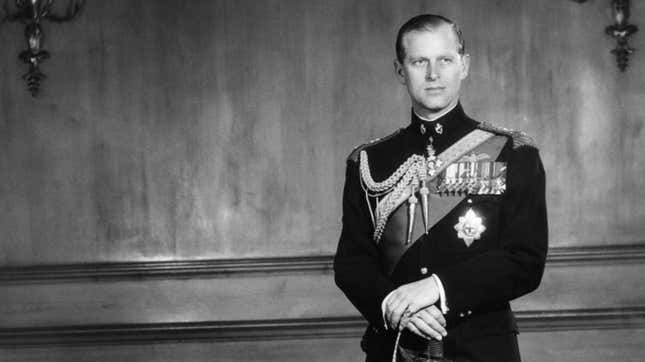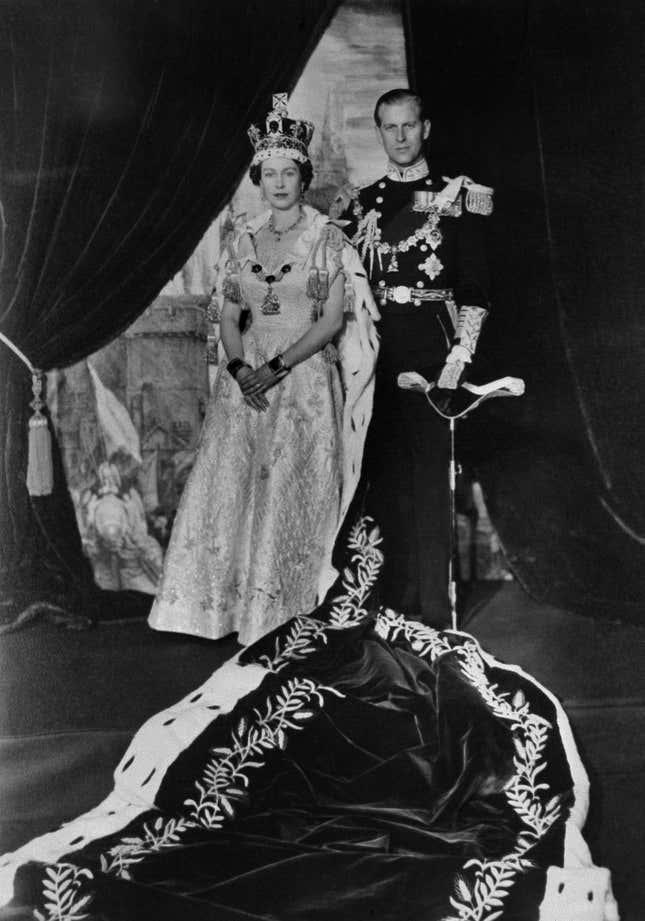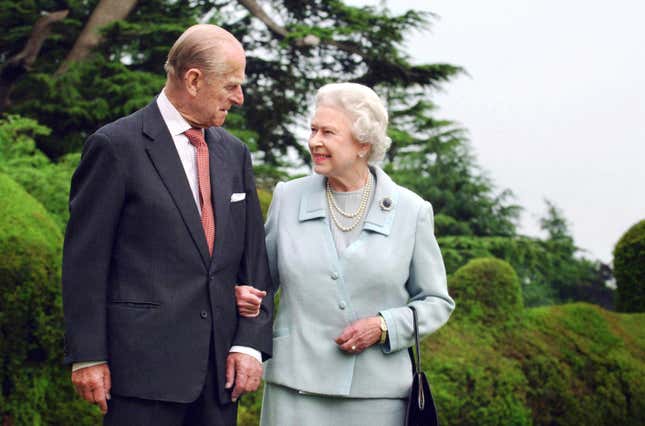The Duke, the Princess and the Making of a Modern Dynasty
In Depth
Image: AP Photo
Princes are thin on the ground these days. While there are still a few royals reigning across Europe, the world of interrelated international royalty that evoked a glittering combination of Grimm’s fairy tales and Ruritania is long dead everywhere except Netflix Christmas movies. But there’s one person left who’s a living connection to the milieu of European monarchy: Prince Philip, Duke of Edinburgh, who will turn 100 years old in June and is currently in the hospital. Buckingham Palace informed media that after a two-week stay at London’s King Edward VII Hospital, he’s been moved to Bartholomew’s Hospital for further treatment of a stubborn infection and a “preexisting heart condition,” but that it’s responding to treatment and he “remains comfortable.”
Philip was a prince without a home or much to his name when he met the 13-year-old Princess Elizabeth; despite her own sprawling family tree, she grew up embedded in the world of the British aristocracy. Philip was related to half of Europe and bounced around their homes after his family was forced out of Greece by political turmoil. Hot-tempered, prone to saying appalling things, poorly suited to the role of second fiddle, he has spent his life simultaneously supporting his wife and angrily bumping up against the confines of his position. In a sense, he’s the last prince charming, literally a dashing European royal in a glittering uniform—and the realities of his life are an excellent testament to the complexities of what that role actually entails, as well as the limits of the “Prince Charming” fantasy itself.
He is among the last living links to the tightly interconnected world of European monarchy as it once existed. He was born Prince Philipos of Greece and Denmark of the House of Schleswig-Holstein-Sonderburg-Glücksburg, in 1921, at a summer palace on Corfu. The dynastic name is cobbled together from several places along the Danish/German border, a hotly contested piece of real estate with a duke who parlayed his way onto the throne of Denmark in the 19th century. His mother, Alice of Battenberg, was a great-granddaughter of Queen Victoria, born in Windsor Castle. In his sepia-toned baby photos, he could easily be mistaken for a stray Romanov in the last days before the revolution and, in fact, his great aunt was Alix of Hesse, later known as the ill-fated Empress Alexandra of Russia, who met her end in a Siberian basement just three years before Philip was born. (Related to the Romanovs on both sides of the family, he was one of three people whose DNA was used to identify their bodies.)
Philip’s uncle was Constantine I, King of Greece. Philip was a prince of both Greece and Denmark because the monarchy of Greece was a tenuous and relatively recent invention, with an imported royal family. In the 1820s, Russia, Britain, and France backed a Greek bid for independence from centuries-long Ottoman control of the peninsula—the conflict that Delacroix painted and where Lord Byron died—and then, for their efforts, took it upon themselves to install a king. They first offered the crown to Leopold, the youngest son of the Duke of Saxe-Coburg-Saalfeld, one of the many small German kingdoms that still existed as independent entities. (Otto von Bismark dubbed it the “stud farm of Europe”—an unimportant but convenient place for sourcing a sufficiently titled husband.)
Leopold turned it down, eventually accepting the crown of the newly independent Belgium instead, and so they turned to Otto, the younger son of King Ludwig I of Bavaria (another independent German-speaking territory). Otto was booted in 1862; after more rooting around the various courts of Europe, they finally found someone to take the crown: Prince Wilhelm of Denmark, who in 1863 became George I of Greece. He was eventually assassinated. The cycle of collapse and restoration continued off and on until the 1970s—frequently to the point of farce and confusion—but Philip and his family exited the picture in 1922.
Philip’s father, Prince Andrew, was a younger brother of Greek king Constantine I and—in the frequent manner of younger royal sons—had a high rank in the Greek military; during a military coup, he was accused of treason for his part as a commander in the disastrous Greco-Turkish War. He was convicted and it took the intervention of George V to save him. The family were evacuated from Greece on a British battleship, Philip famously transported in a crib made from an orange crate. They settled in Paris, living off wealthy relatives, until the family unit essentially dissolved in 1930, when his four older sisters married German aristocrats in rapid succession—three of them to men who would eventually become Nazis—and his parents’ marriage dissolved. His mother suffered a breakdown, spent years at a sanatorium, and when she recovered returned to Greece, took vows as a nun. She spent the war years sheltering Jews, for which she is honored at Yad Vashem. His father, on the other hand, chose the stereotypically aristocratic route and decamped to Monte Carlo where he set up house with his mistress. Ten-year-old Philip, now a poor relation, was bounced around Europe, spending much of his time at boarding schools; asked by an interviewer in the early 1990s what language he spoke at home, he retorted: “What do you mean, ‘at home’?”
Ultimately, he landed in school in the United Kingdom, at Gordonstoun. That put him firmly in the orbit of his Battenberg relations, now the Mountbattens, having anglicized their name during World War I alongside their relatives, the now-Windsors, to avoid anti-German sentiment. Philip still had family on the continent—there are pictures from his sister’s funeral in which he is surrounded by high-ranking Nazis—but he entered Britain’s Royal Navy and ultimately served in World War II. And his uncle Louis Mountbatten had very big, iconically British aspirations for him. Mountbatten, who was a high-ranking naval officer in World War II and as well as the Viceroy of India who oversaw the disastrous Partition, was equally ambitious in his dealings with his royal relations, the Windsors, and he thought that his nephew Philip was a perfect match for the young princess who would eventually become queen.
The love story goes that Elizabeth fell permanently in love with Philip at 13 years old, on a visit to the Royal Navy College, where he was a dashing 18-year-old cadet, and that was that. But the real-world details were, as always, much more complicated. Many of the sticklers at the Palace opposed the relationship. He was an outsider with “a distinctly Continental flavor,” as biographer Sally Bedell Smith puts it. He wasn’t deferential, he hadn’t gone to Eton—horror of horrors—and he was a foreigner, with all that German family. Not to mention that he had no money, no home, and nothing, really, beyond a roguish smile, a near-worthless title, and the fact that he looked very good in a naval uniform. The Queen Mother, in particular, was none too sure about Philip, even as Mountbatten constantly pressed his case.

But even if he didn’t fit the bill of a Windsor consort from the perspective of courtiers and the Queen Mother, he certainly fit the romantic stereotype of a prince, and that’s the role in which he was reliably cast upon his engagement to the besotted Elizabeth for an audience of women all over the world. The happy couple offered a bit of a PR triumph for the establishment, too. Newsreels from the wedding peddled a moment of fairy-tale escapism for a country that was still emerging from the Second World War; “And this was a love match. No wonder the people cheered themselves hoarse as the young bride and her gallant groom returned to the palace on their wedding day,” went the cheerful voiceover from the British Movietone coverage.
Even after Elizabeth got her man, marrying in 1947, their road wasn’t smooth. (None of his sisters were invited to the wedding, but the crowned heads of several European nations attended.) The place of a queen’s husband had always been a particular problem of women ruling in their own right; Elizabeth I solved it by never marrying, while Victoria wholly involved Albert in the business of sovereignty. Philip was a proudly macho Navy man and a prince in his own right who found himself in a structurally subservient role. He did not take to the position well. In the early days, Philip continued to lock horns with his traditionalist mother-in-law and the old-fashioned courtiers in the Palace, struggling to carve out a place for himself. There was a big, early fight about their children’s surnames, which was intricately intertwined with the larger power dynamics within their relationship. Philip fought for his children to have the last name Mountbatten; the Palace publicly announced it would remain Windsor. His biographer quotes him complaining in private: “I am nothing but a bloody amoeba. I am the only man in the country not allowed to give his name to his own children.”
Nor did the issue go away: Sally Bedell Smith writes that the Queen brought it up again when prime minister Harold Macmillan visited Sandringham in January 1960, and he wrote in his diary: “The Queen only wishes (properly enough) to do something to please her husband—with whom she is desperately in love,” adding that, “What upsets me… is the Prince’s almost brutal attitude to the Queen over all this.” Elizabeth eventually granted his wish, after a fashion, after Andrew was born; descendants without titles can use the surname Mountbatten-Windsor, hence Archie’s last name.
And, of course, Elizabeth’s father died young and thrust her onto the throne at 26 years old; Philip had to give up his naval career even earlier than expected. Observers agree that Elizabeth dealt with the complexities of this situation by offering him pretty much carte blanche as head of household within their family—resulting in an oftentimes tense relationship with his eldest child, the sensitive Prince Charles.
Internal palace politicking didn’t spill out into the public eye the way it does now, but the couple weren’t without their tabloid scandals, either. Outlets in the US and Australia, for instance, were more daring than the British media. In 1957, the Baltimore Sun ran a story that “cafe society figures” were going so far as to talk “openly of a rift between Queen Elizabeth and the Duke of Edinburgh,” prompting a rare public denial from the Palace. There have long been rumors about Philip, some of which are more eyebrow-raising than others, like the one that apparently suggests a night of passion with former French president Valery Giscard d’Estaing. But there’s never been a lick of evidence, and this Telegraph piece marshals a string of denials from people who know him and the Queen.
Eventually, the couple settled into a duet act whereby Queen Elizabeth played the conventional, buttoned-up monarch and Philip followed a few steps behind, playing it fast and loose with behavior that ranged from funny to amusingly crotchety to shockingly rude to downright racist. British outlets often reference his long history of “gaffes,” but it’s a euphemism for frankly offensive, racist remarks. “If you stay here much longer, you will go home with slitty eyes,” he told a British student on a visit to China in 1986; “And what exotic part of the world do you come from?” he once asked a Tory politician of Jamaican descent.
Despite his commitment to casual aristocratic racism, he has also been an unlikely voice for modernization in the royal family. Philip pushed for television coverage of his wife’s 1953 coronation; when they first arrived at Buckingham Palace to live, he swept through, doing away with archaic practices like requiring the footmen to powder their hair and maintaining separate kitchens for commoners and royals. You wouldn’t always know it from the way he’s snarled at photographers over the years, but Philip, perhaps better than anybody else in the Windsor family, has always understood from bitter personal experience that crowns shatter and thrones topple. Asked whether he’d like to visit the USSR, he once responded: “I would like to go to Russia very much, although the bastards murdered half my family.”
This is not to say that Philip’s worldliness extends to a deep understanding of how the other half lives; on a 1969 visit to America he stopped by Meet the Press and casually discussed the royal family’s supposed money problems, claiming, “We go into the red next year, now, inevitably if nothing happens we shall have to—I don’t know, we may have to move into smaller premises,” and adding that, “For instance, we had a small yacht which we had to sell, and I shall have to give up polo fairly soon.”

Philip’s “continental” background receded into the distance the longer he was married to Elizabeth. While the press coverage of the time frequently described Philip as a Prince of Greece, he renounced the titles and claim to the throne before marrying Elizabeth, becoming a naturalized British citizen. Besides, whatever was left of old courtly Europe as an independent world was toast after World War II. (Many of the German nobles had been deeply involved with the Nazis, not just his brothers-in-law.) The historic directory of European royalty, the Almanach de Gotha, stopped publishing in 1944 (though it was revived online in the late 1990s). There are still monarchies—many of them with dynasties related to the Windsors through the prodigiously matchmaking Queen Victoria—but they no longer intermarry with the Windsors. When it came time for Philip and Elizabeth’s children to marry, the era of royals marrying royals was over, and they all looked within Great Britain for their spouses. Even Elizabeth’s younger sister married a commoner.
Over time, Philip and Elizabeth became, instead, an iconically British couple. That’s not to say they were universally beloved—Americans are, if anything, more entranced with the Windsors than the British, and Philip is a controversial figure for all those offensive remarks—but simply that they became a national fixture through sheer long-term staying power. Now his life is wielded as a rebuke against Harry and Meghan, nevermind his long history of pushing against the way courtiers wanted to do things, pushing for changes to the very name of the dynasty. The longevity of Queen Elizabeth II herself is part of what rebuilt the monarchy’s image after the disasters of the 1990s, but the longevity of her marriage to Philip was part of the equation, too. Even as the The Crown introduced a new generation to Philip’s most petulant, arrogant moments, the show didn’t seem to dent the power of the “my husband and I.”
Seven decades of steady marriage—a nearly unfathomable amount of time—eventually transformed the irreverent, traumatized continental prince with no fixed address into an icon of stability, a testament to the power of the Windsor narrative.